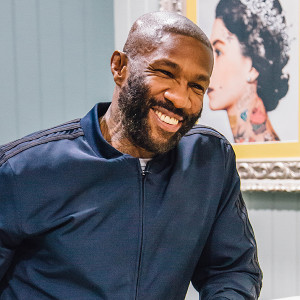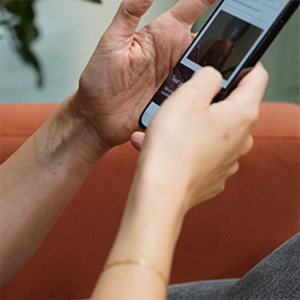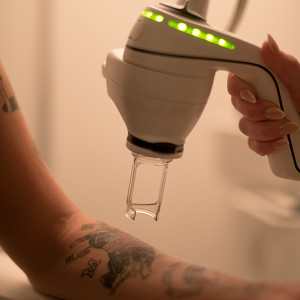Is laser tattoo removal painful? Don't panic - the good news is that with the latest laser technology, tattoo removal shouldn't hurt any more than getting the tattoo in the first place, and some people say it's actually a lot less painful.
Having said that, pain is subjective. The amount of pain that a person experiences during the laser tattoo removal process at our Central London studio can vary depending on a number of factors::
The individual's tolerance to pain
The technology used
The size and location of the tattoo
From celebs to scientists, we look into the pain associated with tattoo removal and why LightSense™ technology is regarded as the most painless laser tattoo removal treatment available.
Publish Date in article
How do scientists measure pain?
Pain is sometimes measured on the Wong-Baker scale, though this is by no means a perfect method. It offers clinicians a way of ranking pain through a series of caricatured faces, each experiencing varying levels of distress.
Pioneering work using brain scans is beginning to offer scientists an objective way to measure discomfort, but we still have a long way to go from the days of asking people to rate their pain through a questionnaire.
Simple factors such as a lack of sleep may make you more susceptible to pain. Brain scans of sleep-deprived individuals have shown a staggering increase in activity in the part of the brain responsible for feeling pain.
No two people experience pain in the same way. For many of us, our threshold varies and can impact our tolerance to pain. Factors such as stress, negative headspace, and hormonal fluctuations all might make someone feel particularly susceptible to pain, whereas feeling positive or having a higher dose of estrogen coursing through the body can act as natural pain relief.
At NAAMA, we’ve learnt a lot from our clients, who, after returning to see great results month on month, taught us a lot about their apprehensions, as well as how we talk about pain and ways of understanding it through comparison.
At the studio we hear everything from the cool as a cucumber “it was comfortable” to the zealous convert: “I didn’t quite believe that it could be painless, but it’s true.” (Reviews of the LightSense™ treatment from Jane and Laura).
Publish Date in article
How pain varies with tattoo removal technology
Actor Mark Wahlberg described his experience of tattoo removal as “dreadfully painful” and likened it to "hot bacon grease getting flicked on you over and over again.” No need for the Wong-Baker scale here then! But tattoo removal technology has come a long way in recent years, it no longer needs to be a painful process.
Older laser treatment technologies are more painful as they deliver higher volumes of energy to the skin to break down the ink pigment. This is what causes discomfort and pain upon application. For example, Q-switched and carbon (CO2) lasers use high-energy beams of light that are absorbed by the tattoo ink, causing it to shatter into smaller particles. These high-energy lasers target the tattoo, but also the skin around it, delivering a powerful energy dosage to break down the pigment that inadvertently can cause a great deal of harm to the tissue.
In 2020, the LightSense™ laser system came to market as the most advanced pico laser available for tattoo removal. Exclusively available at NAAMA, it effectively removes tattoos quickly while being gentle on skin, cutting pain from the process as much as possible.
“Being an aesthetic nurse that specialises in skin, I would highly recommend this to anyone who wants a tattoo removed without the skin damage and pain associated with previous lasers” - CT.
LightSense™ uses much lower energy than the average pico laser. Put simply, less energy means less pain. On top of this the laser has a high repetition rate (that’s how many pulses the laser can send per second), so the area of skin is treated faster than with other lasers.
As well as using ultra-low energy, LightSense’s pulse width, essentially how long the laser pulse is on the skin, is shorter than the average pico laser. Your skin is exposed for far less time than with other lasers. It works a bit like ripping off a plaster, if you do it quickly you feel less pain.
“There’s less pain and fewer side effects,” says Dr. Gintas. “You’re comfortable after the procedure with absolutely no damage to the surrounding skin.”
Jack's experience with LightSense™
Jack’s skin was particularly healthy, allowing him to come every 2-3 weeks for follow-up appointments.
Pain is an entirely personal experience, especially when different lasers are available
With LightSense™ technology we want to demystify the experience of laser tattoo removal. After undergoing tattoo removal with an older technology Kelly Osbourne asked her 2.5 million followers: “who else knows how bad this hurts?” But the truth is, pain is an entirely personal experience. One Osbourne’s pain is another’s tingling sensation. To understand how much of it is down to the technology used, we asked clients who have experienced different laser removal technologies on the same tattoo, how the pain compared.
“I had one session of traditional tattoo removal and it was so painful that I never went back,” says Jack after trying to remove a tattoo on his hip and failing to see results. “Traditional laser tattoo removal is like someone taking a hot poker and stabbing you multiple times around the area until you can’t take it anymore; leaving you blistered and sore for weeks. I don’t even know how the skin repairs from it, it’s so bad.”
“I looked NAAMA up and was a bit apprehensive about how you could remove a tattoo without it hurting. But I realised after one or two sessions that it doesn’t hurt at all and I can come back more often.” With NAAMA's skin-kind technology, clients can return more often for treatment; as frequent as every 2-3 weeks in some cases.
Lily experienced blisters and scarring from using an older removal technology but described her experience at NAAMA simply as “amazing.”
“Pain-wise it’s 10% of what I experienced before, with other places I couldn’t handle it, I’d have to take paracetamol and use numbing cream and an ice pack, the whole works! It’s really different at NAAMA.”
Publish Date in article
Still apprehensive? We use straightforward pain management techniques
“Cold air makes the treatment more comfortable and less painful,” says Beatriz on Trustpilot.
Clients tend to want simple, straightforward pain relief. When applied to the treatment area, cold air has been found to be effective at both relieving pain and speeding up the recovery of the skin. Aside from this, some clients choose to apply one of our ice packs to their skin.
But we hope that word of mouth is comforting enough.
As Lily says, the day after using LightSense™ “I’m good to go, but before I’d have to cancel a whole week and plan when I was going to do it.”
How long after laser tattoo removal does it hurt?
We asked our team: “Depending on the size and density of your tattoo there are around 45 minutes or so post-treatment where you may experience a burning sensation similar to sunburn,” says Rebecca, a consultant at NAAMA studios.
“This will gradually decrease until all you feel is mild sensitivity when touching the area for up to three to seven days post-treatment.”
“Again, the size and density of the tattoo have a big influence here - for a micro, we expect you not to feel anything after 24 hours.”
Does laser tattoo removal hurt less after each session?
“As we are progressing through your removal, we need to target the deeper layers of ink,” Rebecca says.
“In theory the less ink you have, the less painful the treatment should be. However, because we must increase the settings to achieve the desired results the pain does not decrease as we progress.”
Our clients come in with an array of tattoos, from minor details to blackwork, on everything from their feet to their faces. As you might expect, the size and location of your unwanted tattoo will influence your experience of removing it. Certain body parts are more sensitive than others (fingers, wrists, ankles, armpits, elbows, ribcage, and forehead), and a large tattoo will usually require more laser tattoo removal sessions.
So what does tattoo removal feel like today in NAAMA's Central London studio?
Well, a bit like having a tattoo in the first place - although it's also been likened to having a rubber band snapped against the skin.
What hurts more, getting a tattoo or laser removal?
“It was no more painful than actually having a tattoo,” says Elisa after completing her removal at NAAMA. Each person’s experience with pain is unique, so choosing the right technology is crucial. As we’ve seen from client testimonials, it can entirely change your removal experience. The LightSense™ laser system is only available at NAAMA and has been specially designed to work on ultra-low energy, causing an absolute minimum of damage to the skin.
We endeavour to make your laser tattoo removal session in our Central London studio as pain-free as possible
If you are still apprehensive about feeling pain during laser tattoo removal, we encourage you to come to our Central London studio and try the LightSense™ laser technology for yourself with a consultation and patch test. Our consultants are specially trained with this technology and are the experts to speak to during your session, especially if you have any concerns.
For trends in breakthrough laser tattoo removal technology, here are NAAMA's top FAQs.
What is the best laser for tattoo removal?









